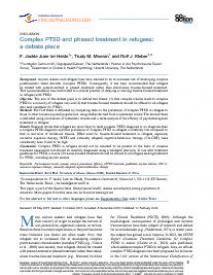Complex PTSD and phased treatment in refugees: a debate piece
Background: Asylum seekers and refugees have been claimed to be at increased risk of developing complex posttraumatic stress disorder (complex PTSD). Consequently, it has been recommended that refugees be treated with present-centred or phased treatment rather than stand-alone trauma-focused treatment. This recommendation has contributed to a clinical practice of delaying or waiving trauma-focused treatment in refugees with PTSD.
Objective: The aim of this debate piece is to defend two theses: (1) that complex trauma leads to complex PTSD in a minority of refugees only and (2) that trauma-focused treatment should be offered to all refugees who seek treatment for PTSD.
Methods: The first thesis is defended by comparing data on the prevalence of complex PTSD in refugees to those in other trauma-exposed populations, using studies derived from a systematic review. The second thesis is defended using conclusions of systematic reviews and a meta-analysis of the efficacy of psychotherapeutic treatment in refugees.
Results: Research shows that refugees are more likely to meet a regular PTSD diagnosis or no diagnosis than a complex PTSD diagnosis and that prevalence of complex PTSD in refugees is relatively low compared to that in survivors of childhood trauma. Effect sizes for trauma-focused treatment in refugees, especially narrative exposure therapy (NET) and culturally adapted cognitive-behaviour therapy (CA-CBT), have consistently been found to be high.
Conclusions: Complex PTSD in refugees should not be assumed to be present on the basis of complex traumatic experiences but should be carefully diagnosed using a validated interview. In line with treatment guidelines for PTSD, a course of trauma-focused treatment should be offered to all refugees seeking treatment for PTSD, including asylum seekers.
In: European journal of psychotraumatology, ISSN 2000-8066 | 7 | 28687
http://www.ejpt.net/index.php/ejpt/article/view/28687


